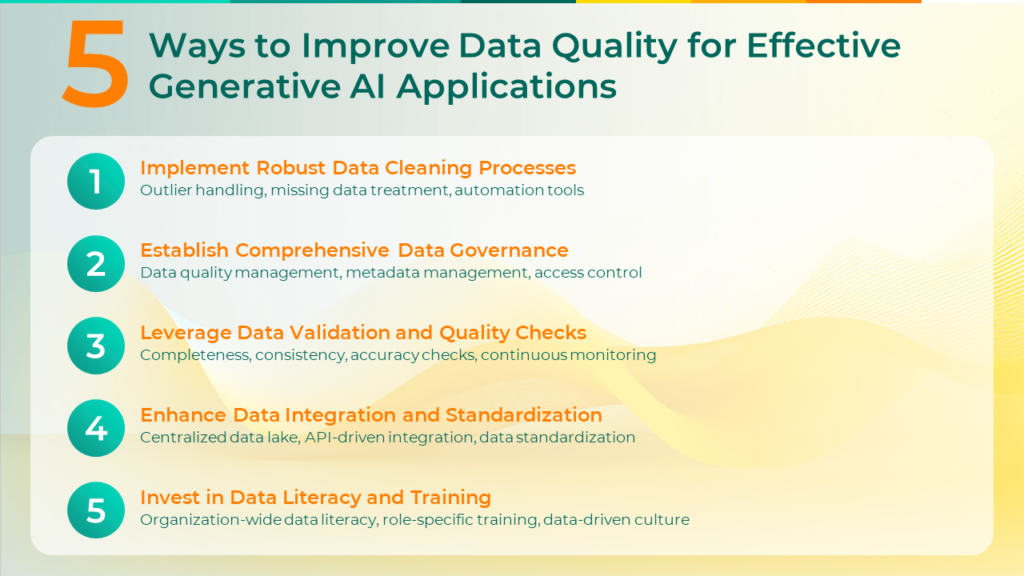Generative AI (GenAI) has opened new possibilities for businesses, revolutionizing how we approach complex problems and create innovative solutions. However, as organizations embrace this transformative technology, a critical factor often gets overlooked: the quality of the underlying data.
Our friends at Databricks released a great document entitled, “The Big Book of GenAI” and like the name implies, it is big (118 pages). I wanted to write about the data quality concepts covered by Databricks in their document, since it’s a field I deal with extensively alongside our clients.
No matter where you are on your path to deploying GenAI applications, the quality of your data matters. Deploying production-quality GenAI applications presents significant challenges. These applications must be accurate, governed, and safe – a standard that can only be achieved with high-quality data as the foundation.
This blog post will explore five ways to enhance your data quality, ensuring that your GenAI applications meet and exceed expectations in performance, reliability, and value generation.

1: Implement Robust Data Cleaning Processes
Data cleaning is a crucial first step in improving data quality for GenAI applications. The quality of your GenAI output is directly tied to the quality of your input data.
Key aspects of data cleaning include:
- Identifying and handling outliers using statistical methods, visualization, and domain expertise
- Addressing missing or incomplete data through imputation, deletion, or flagging
- Leveraging automation tools for large-scale data cleaning
By implementing robust data cleaning processes, you lay a strong foundation for high-quality GenAI applications, improving model performance and increasing the trust and reliability of your AI-generated outputs.
2: Establish a Comprehensive Data Governance Framework
A robust data governance framework is essential for maintaining high-quality data in GenAI applications. It ensures that data is consistent, trustworthy, and used appropriately throughout your organization.
Key components of an effective data governance strategy include:
- Data Quality Management – Establish standards and processes for ensuring data accuracy, completeness, and consistency.
- Metadata Management – Maintain clear definitions and documentation for all data elements used in your GenAI models.
- Data Access and Security – Define who can access what data and under what circumstances, ensuring both data protection and appropriate use in AI models.
- Data Lifecycle Management – Establish processes for data creation, storage, use, archiving, and deletion, crucial for managing large datasets used in GenAI.
- Compliance Management – Ensure adherence to relevant regulations and internal policies, particularly important when dealing with sensitive data in AI applications.
A strong data governance framework contributes to GenAI success by ensuring consistency, traceability, ethical use, and scalability of your data processes.
Best practices for implementation:
- Start with clear objectives
- Involve stakeholders
- Use appropriate tools
- Continuously improve
- Foster a data-driven culture
3: Leverage Data Validation and Quality Checks
Implementing robust data validation and quality checks is crucial for maintaining the integrity of your GenAI applications. These processes help ensure that your models are working with reliable, accurate data.
Types of data quality checks:
- Completeness – Are there missing values (e.g., columns or rows)?
- Consistency – Does the data agree with other data sources?
- Accuracy – Does the data accurately represent reality?
- Timeliness – Is the data too old or stale to be valuable?
- Uniqueness – Is the data duplicated within a single source?
- Validity – Is the data fit for purpose regarding format and content?
Implement automated validation processes and continuous monitoring systems to maintain data quality over time. This includes data profiling, rule-based validation, statistical analysis, and machine learning for anomaly detection.
By leveraging comprehensive data validation and quality checks, you can significantly improve the reliability and performance of your GenAI applications.
4: Enhance Data Integration and Standardization
Effective data integration and standardization are crucial for maintaining high data quality in GenAI applications, especially when models rely on diverse data sources.
Challenges include data silos and inconsistent formats, which can lead to incomplete information, inconsistencies, and difficulties in maintaining data quality across the organization.
Strategies for effective data integration:
- Implement a centralized data lake or lakehouse architecture
- Develop robust APIs for seamless data exchange
- Use ETL/ELT processes
- Employ data virtualization techniques
Data standardization ensures that models receive consistent inputs, data from different sources can be easily combined, and results are more interpretable across different use cases.
Tools and techniques for streamlining integration include data catalogs, schema management, data lineage tracking, automated quality checks, and unified data platforms.
5: Invest in Data Literacy and Training
While technological solutions are crucial, the human factor in data quality cannot be overlooked. Even with the most advanced AI systems, human judgment and expertise remain critical.
Employees who understand the importance of data quality and know how to handle data correctly can significantly improve the overall quality of data feeding into your GenAI applications.
Investing in data literacy and training across your organization is essential for maintaining high-quality data for your GenAI applications.
Data literacy is important because it:
- Helps employees understand the impact of their data-related actions on AI outcomes
- Enables better communication between technical and non-technical teams
- Promotes a culture of data-driven decision making
- Aids in identifying potential issues or biases in data used for AI applications
Implement training programs covering basic data concepts, data quality principles, data governance, AI and machine learning basics, and role-specific skills.
Foster a data-driven culture by:
- Leading by example
- Encouraging data exploration
- Recognizing data quality efforts
- Maintaining regular communication about data quality impact
- Promoting collaborative problem-solving
By investing in data literacy and training, you empower your employees to become active contributors to data quality improvement.
Conclusion
The quality of data is paramount for the success of GenAI applications. By implementing these five strategies – robust data cleaning, comprehensive data governance, rigorous validation and quality checks, enhanced data integration and standardization, and investment in data literacy – organizations can significantly improve their data quality and the effectiveness of their GenAI applications.
Remember, the journey to high-quality data is ongoing. As your GenAI applications evolve and grow, so too should your data quality practices. Regularly reassess and refine your approaches to ensure they continue to meet the needs of your AI initiatives.
Start implementing these strategies today, and watch as your GenAI applications deliver increasingly accurate, relevant, and impactful results. The future of AI is bright – and it’s built on a foundation of high-quality data.




